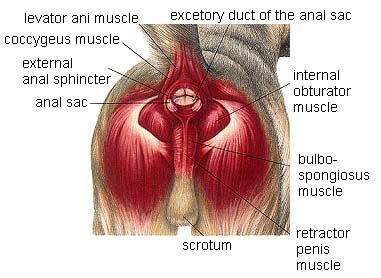Table of Contents
Summary:
"Canine anal glands have problems when they are not regularly expressed causing your dog to possibly scoot across the floor on its anus, whimper or cry. Glands can be expressed at home. For chronic problems the glands can be surgically removed. First try a dietary supplement designed to help with this condition."
Overview
Canine anal glands are scent glands located around a dog's anus. The anal glands are located between the internal and external anal sphincters (the muscles that control the passage of stool from the rectum). The glands store and secrete a strong-smelling, oily substance that is used for marking territory. Humans do not normally smell the fluid, but other dogs do.
Canine anal glands vary in size according to the breed, but generally range in size from the size of a pea to that of a kidney bean. The anal glands empty through two openings on either side of the dog's anus. When the anus is stretched as stool is passed, the sphincter muscles squeeze the glands and cause the fluid to be secreted.

Symptoms of Canine Anal Gland Problems
If the dog anal glands are not emptied on a regular basis, the fluid becomes thick and can clog the openings of the glands. The glands can become impacted, infected, or develop an abscess. Infected or impacted glands are itchy and uncomfortable for a dog. Dogs may lick or bite at their anus or may "scoot" across the floor on their bottoms with their tails up in an attempt to empty the glands and relieve the discomfort. Infected and impacted anal glands produce a foul smell that is quite noticeable.
Infection can occur if bacteria enters glands that are not emptying properly and lead to an abscess. Your dog may whimper or cry when attempting to defecate. Abscesses can be painful for your dog and will require the attention of a vet and possibly antibiotics to clear the infection.
Obese dogs are more likely to have problems with anal glands than dogs of normal weight. This may be because fat skin folds block the pores and prevent them from draining or because it's more difficult for these dogs to groom themselves and encourage natural drainage.
Treatment of Clogged Canine Anal Glands
Take your dog to the vet if you think he has impacted or infected anal glands. Early treatment is important in order to prevent the development of an abscess. Your vet will express the glands manually. If the glands appear infected, antibiotics will be prescribed. In dogs that repeatedly develop anal gland abscesses, the glands can be surgically removed.
Expressing Canine Anal Glands Manually that are Clogged
Impacted or infected glands may need to be expressed manually. Use your fingers or a thumb and forefinger to gently apply pressure on either side of the anal opening - on the outside of the glands. Press inwards and upwards and you should see the fluid being expressed. If you notice signs of blocked anal glands such as scooting or a bad smell, try manually expressing the glands. Infected glands may need to be expressed daily until the infection clears up.
Prevention of Problems with Canine Anal Glands
Check the glands regularly and express them when necessary. If your dog gets this condition often try a dietary supplement that is formulated for anal gland problems such as Pet Alive AnalGlandz. This is a way to treat infected anal glands naturally.
If your dog has anal gland problems due to constipation or irregular bowel movements consider a high fiber supplement such as Natural Moves for healthy digestion and treatment of constipation in dogs.
Reference
Anal Sac Disease
Hoggan, Sarah
Washington State University
